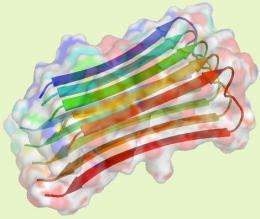Problem proteins in Alzheimer's

(PhysOrg.com) -- In Alzheimer's disease, two proteins are known to accumulate and build up in the brain. One protein called amyloid β aggregates into large disruptive ‘plaques’, while tau protein forms tangled fibres within nerve cells.
Research has tended to focus on amyloid β, since small numbers of these proteins bound together are known to be toxic to the neurons in the brain.
But there is some evidence to suggest tau protein may also be involved in the processes which eventually lead to the memory problems and cognitive decline seen in Alzheimer’s.
Researchers at Oxford University have used a sensitive laboratory model of learning and memory to investigate any connection between amyloid β and tau. They found that tau is absolutely required for amyloid β to disrupt the function of the mouse nerve cells in the lab model. The results were published last month in the Journal of Neuroscience</i>.
"This is one of the first investigations of the mechanisms linking amyloid β and tau that is relevant to the early stages of Alzheimer’s disease," says Dr. Mariana Vargas-Caballero of the Department of Physiology, Anatomy and Genetics, who led the work.
Mariana and colleagues looked at the strengthening of connections between mouse neurons in a dish, since the strengthening of connections in the brain’s neural circuits is thought to be how memories are formed and consolidated.
They found that amyloid β impairs the strengthening of the neural connections, or ‘synaptic plasticity’, although the nerve cells remained healthy in all other aspects that they could measure. But crucially, in neurons from mice engineered to have no tau protein, the amyloid β had no effect on this cellular model of memory.
"This came as a complete surprise. It is a strong and reproducible effect," says Olivia Shipton of the Department of Physiology, Anatomy and Genetics, who is first author on the paper.
The team then went on to show that blocking the activity of tau using a specific chemical inhibitor also prevented the detrimental effects of amyloid β on the mouse neurons.
While it might be tempting to leap to the conclusion that this inhibitor could offer a promising avenue for the development of drugs to slow or halt Alzheimer’s onset, Mariana is more cautious. She says the stage the research is at is more about understanding the disease processes of early Alzheimer’s.
"We want to know how amyloid β can lead to impaired synaptic plasticity as we can assume that this is like what happens in early Alzheimer’s disease. The findings should help us unravel the mechanism involved," she explains.
"There is a huge gap in understanding what is relevant to the situation in humans. But we do now have a sensitive system to study what links amyloid β and tau, and tau and dysfunction in neural connections.
"It is possible that pinpointing where in the chain of events tau is located could allow people in time to develop drug candidates to slow or stop the disruption of neural connections," she adds, but believes that more research is required to first understand the molecular pathways involving tau.
More information: www.jneurosci.org/cgi/content/abstract/31/5/1688













